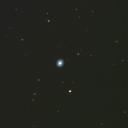I was out on Friday night (the 2nd) and managed to get a few new objects to add to the list. It was fairly clear with wispy high cloud, but as the night went on the dew became an issue with water running down the outside of the scope.
After taking the RA axis apart and reassembling I was keen to see if there was any difference but a hasty polar alignment I think was to blame for the image subject drifting up the screen with a slight zig-zag left to right. I recon if I can learn how to drift align I’ll be a lot closer now to getting longer exposures.
So I pointed the scope westwards, n-star aligned on Vega, Rasalhague and Altair then slewed to M27 for a quick check to make sure the goto was working. It was dead centre so I captured a few images here, then moved on to M57 as usual.
In order to find comet Holmes(17P) I needed to point the scope to the east which meant realigning the mount. This time I had a few problems trying to centre on some brighter stars as eastwards is over the top of my house which makes it difficult to get to the finder because of the angle. I settled on Mirfak, Algol and Almach but only after a lot of “left a bit, right a bit, up a bit ….” you  get the idea, so I was surprised when I told the scope to goto the comet is was just off centre. I have a couple of images like this all taken from the same 100x10sec avi. I’ve been trying to reprocess the image to show some of the internal structure (see left) that others have been able to bring out, but so far there’s not much to see. The comet is so big only the heart of it fits into my feild of view with most of the surrounding gas and very faint tail cropped. Note the stars are elongated as the comet is moving at a different rate to the background.
get the idea, so I was surprised when I told the scope to goto the comet is was just off centre. I have a couple of images like this all taken from the same 100x10sec avi. I’ve been trying to reprocess the image to show some of the internal structure (see left) that others have been able to bring out, but so far there’s not much to see. The comet is so big only the heart of it fits into my feild of view with most of the surrounding gas and very faint tail cropped. Note the stars are elongated as the comet is moving at a different rate to the background.
As the scope was pointing eastwards I picked out some clusters that were missing from my messier chart, namely M35, M36, M37 and M38. The problem again is field of view, these clusters are too big for my small CCD. I spent some trying playing with EQMOD Mosaic but couldn’t put the pieces together. I think there was too much drift in each avi which makes the processed images smaller and therefore the edges don’t overlap as they should – if only I’d spent more time doing the polar alignment!!!
As the night went on, more objects emerged above the roof, I picked out Atlas and Merope in The Pleiades but couln’t see any nebulosity, I then moved on to a shot of Atik in Perseus before finally getting my first view of M1. I’d tried several times in the past to find M1 visually but with the long exposure set to 40 seconds I managed enough frames to give me my first photo, which as my old school teacher would say, “could do better”. It’s a start, hopefully the next time around I’ll be able to image this supernova remnant with a little more skill than I managed this time, but at least I can fill the space on my messier chart!
Mars had appeared by this time, but everything was soaking from the dew so I decided to pack up and dry everything off. Not a bad night, but I should make better use of the time between good nights to practice, learn and perfect the skills I need when the stars do come out. Next time…









